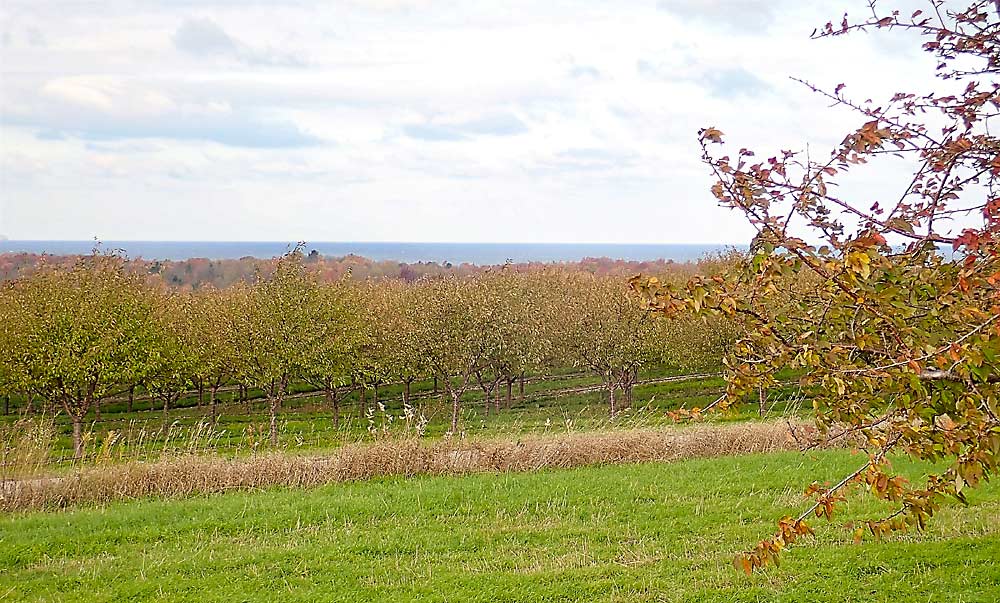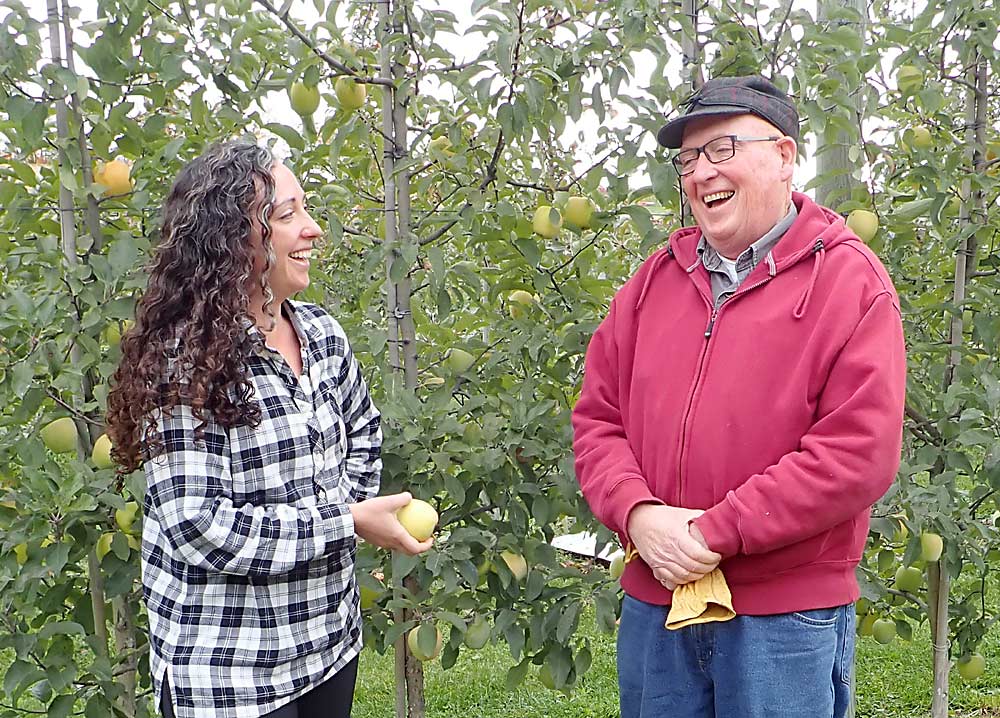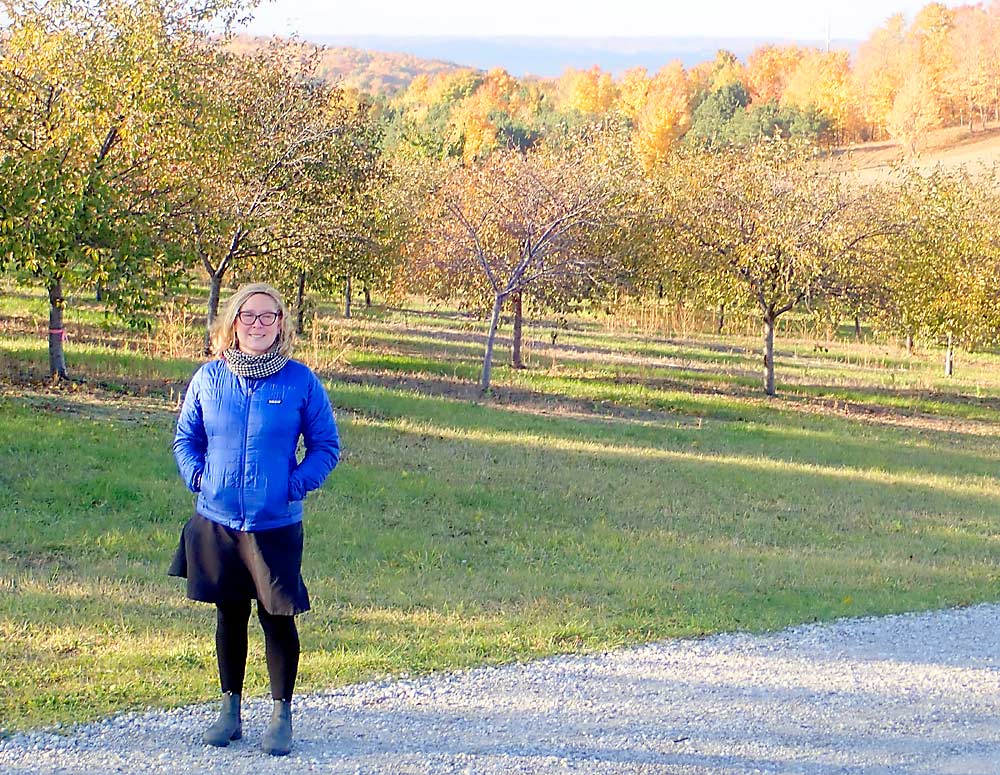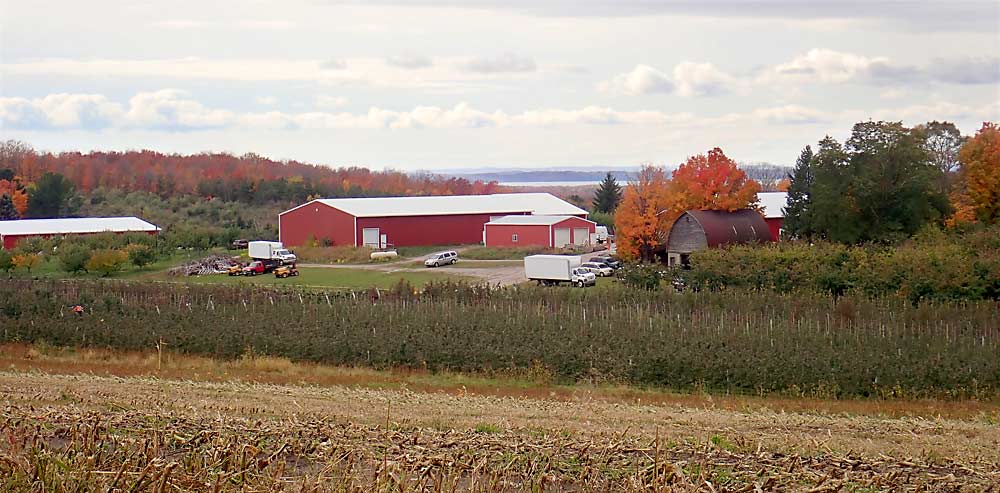
On a cloudy October morning, Northwest Michigan grower John King and his daughter, Juliette McAvoy, sat at a table in the staff lunchroom at King Orchards’ farmers market and began ticking off the unusual weather patterns that are disrupting operations on their 400-acre farm: frigid winter cold that is killing young trees; wild spring temperature swings destroying blossoms; severe rainstorms causing erosion and drainage issues; higher annual average temperatures allowing invasive species to arrive and flourish; and unprecedented fruit-damaging hailstorms. “Am I concerned? Yes, absolutely,” King said about the future of the orchard he owns with his brother, Jim.
“We know that agriculture is inherently risky and has been. That’s not new,” added McAvoy, project manager at the orchard. “But we feel that it’s becoming riskier and harder to do things to mitigate those risks through horticultural practices and business practices such as diversifying.”
When it rains, it pours
King Orchards sits within the prime fruit-growing area in Northwest Michigan, a narrow band of land that hugs the shoreline of Lake Michigan. Growers reap the benefits of the water’s moderating climatic effects, but in recent years, weather conditions in the region have become increasingly erratic, according to Michigan State University extension specialist Nikki Rothwell, coordinator of the Northwest Michigan Horticulture Research Center.
“I feel like this climate change and this unpredictability has just upped the ante and made it even more risky to grow fruit,” she said.

Precipitation is one aspect of that climate variability, said Ken Kunkel, a research professor at North Carolina State University who oversees state climate summaries for the National Centers for Environmental Information (NCEI). NCEI climate data show that annual precipitation is on the rise in Michigan, most notably in spring and fall. For instance, the average statewide rainfall for September–October in the 20th century was 6.07 inches, but the average over the past five years was 8.35 inches. Precipitation for March–April over the past five years averaged 5.84 inches, compared to the 100-year mark of 4.64 inches.
“And this isn’t just Michigan,” he said. “It’s really much of the eastern part of the U.S. where we’re seeing this upward trend. It signals a real change in climate.”
The frequency of extreme rain events (2 inches or more within 24 hours) is also increasing in Michigan and beyond. “In general, in the Northeast and Midwest, we’ve seen more flooding events over the last 20 to 30 years or so,” Kunkel said, noting that he expects more and more areas to face heavy rains and flooding issues in the coming years.
The shift from steady, parsed-out rains to less frequent deluges means eroded soil and flooded-out young trees. King has seen both. Emphasizing just how destructive these downpours can be, he described the scene when a 12-foot-wide, 6- to 8-inch-deep rushing river raced down one of the just-planted sweet cherry orchards on a hillside at King Orchards, following a torrential rainfall.
Running hot and cold
Temperature has likewise become more erratic, Rothwell said. Although Lake Michigan still provides a moderating effect, out-of-season temperature swings have gone from freak occurrences to much more common ones. As an example, she cited spells of 80-plus degrees in March in both 2002 and 2012, which prompted tart cherries to begin blooming. “There was no way in Northern Michigan that we were not going to have a freeze event after that, and we lost the tart cherry crop in 2002, and we lost it again in 2012,” she said. “Before that, we hadn’t lost a crop since 1945.”
NCEI data clearly show an upward overall temperature trend, Kunkel said. “You can see lots of ups and downs (in historical data), and you can expect that, but it’s been warmer over the last 20 to 25 years than the long-term average.” The mean annual temperature from 1901–2000 in Michigan was 43.6 degrees Fahrenheit. Since 2000, every year except one has been above that average, with the annual average temperature at 45.4 degrees.

Cold snaps are also becoming more frequent and more severe, Rothwell said. “The other thing that we saw — and we haven’t seen this before — was freezing temperatures when Honeycrisps were still on the tree this fall,” she said. “We are trying to better understand the impacts of fall freeze events on future crops. We have seen damage to buds when temperatures drop suddenly in fall rather than a slow decline in temperatures where trees can acclimate properly.”
King has also seen the effects of both temperature extremes.
“To my knowledge, we had never gotten below minus 12 up on this hill and in this proximity to the lake, but we’ve seen two winters in the last 10 where temperatures have dipped well below minus 15 — even down to minus 24 — and that took out my young trees,” he said.
That included all of his apricots, many of the peaches and nectarines, and even a good number of young apples. Like other growers in the region, he lost all of his tarts in both 2002 and 2012, and he also lost them again this past year when an unusually cool spell in May was followed by a sudden surge to 80 degrees. “The trees bloomed, but the bloom came and went in about three days, and the cherries didn’t set, so we had only about 15 percent of our crop,” he said.
Be the change
To survive the changing weather patterns, growers are trying various tactics. For instance, some larger tart operations are buying land and planting acreage in Southwest Michigan, in part “because they want to make sure that if they lose the crop here, they still have something down south,” Rothwell said. Likewise, she is seeing Southwest Michigan growers moving some of their apple operations to Northwest Michigan.
Rothwell also sees many Northwest Michigan growers diversifying to hedge their bets. “I know one grower who was known for his tarts but just put in a 60-acre planting of high-density SweeTango and Honeycrisp,” she said.
At King Orchards, operations are shifting to try to keep up with the climate shifts. The higher frequency of extreme rains, for example, means rebuilding eroded areas, running sock pipes, installing drain tiles and taking other steps to combat floodwaters, King said. Hail has also become so frequent and damaging that the orchard now buys hail insurance, McAvoy said.

In addition, warmer springs encourage cherry leaf spot, apple scab and various other diseases that thrive in heat and humidity, so growers are struggling to adjust their spraying strategies, Rothwell said.
Researchers want to design spray guidelines to keep pace with changing weather patterns, too. To that end, she is working with MSU pathologists George Sundin and Tyre Proffer to determine whether the cherry leaf spot model needs refinement in light of the wetter springs.
Data from the lab of MSU entomologist Rufus Isaacs are also showing spotted wing drosophila (SWD) does well in heat and humidity, Rothwell said.
“There are a lot of these changing weather patterns that are influencing our management,” she said. “We as scientists can’t fully explain them yet, so we can’t provide recommendations to growers.”
SWD poses a major problem at King Orchards. To fight it, the orchard uses more powerful insecticides early on and then alternates pyrethroids on a 5- to 7-day schedule as harvest nears, King said.
“You’re running yourself ragged during harvest, spraying all night and shaking all day. That falls heavy on my kids, and we’re just busting our asses,” he said. “It’s a big human toll, it’s a big expense in pesticides, fuel and equipment, and it’s terrible for the environment.”
As growers struggle to take all of the necessary steps to keep up with weather-related issues on the farm, each season seems to bring yet another weather-related challenge that makes farming an increasingly risky proposition, McAvoy said. The answer, she believes, is to start tackling the root of the problem: climate change.
“To be honest, I just can’t believe that agriculture as an industry isn’t on board and demanding more proactive government policies,” she said. “Agriculture is one of the most powerful industries. If agriculture got behind climate-change mitigation, we would be moving at a lot faster pace as a country.”
—by Leslie Mertz






Leave A Comment